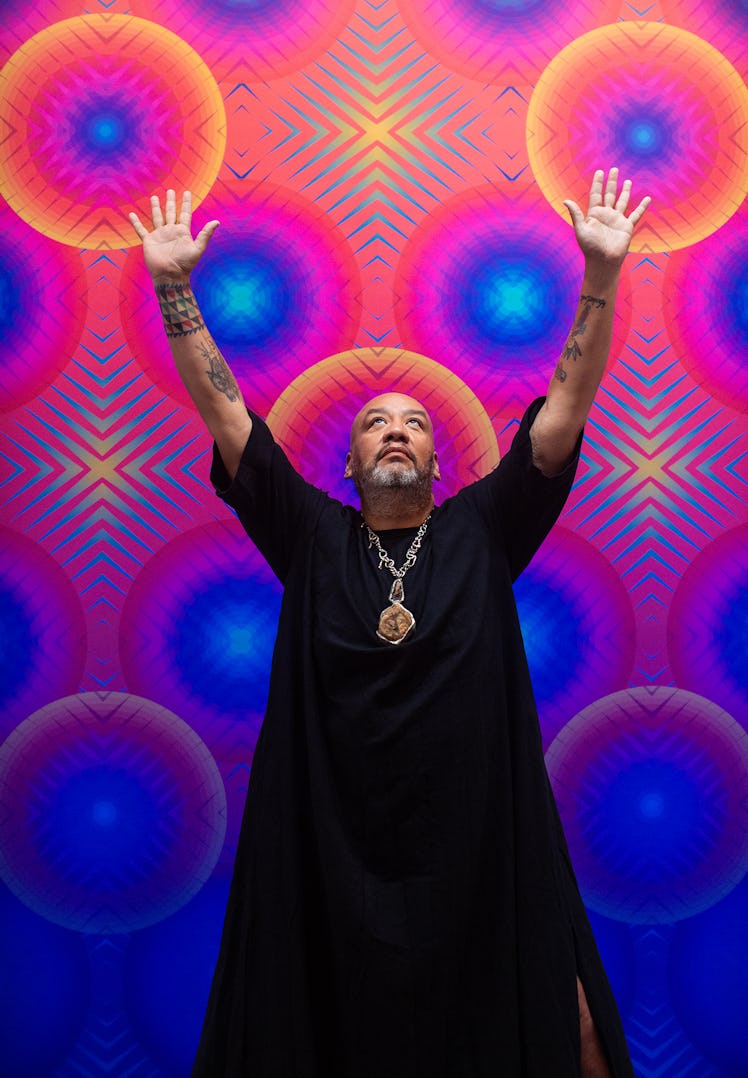For Jeffrey Gibson, Beauty Has a Purpose

You will represent the United States in a solo exhibition at the upcoming Venice Biennale. As the first Indigenous artist chosen to do so, do you feel a sense of responsibility?
I was daunted by what it means to represent the United States, all the complications with Native American history in this country, and all of the oppression we suffered. My goal is to create an atmosphere where everyone is invited, not to create a new hierarchy or form of exclusion.
You were born in Colorado, a member of the Mississippi Band of Choctaw Indians, and are of Cherokee descent, but your upbringing and your work have taken you around the globe.
Our motto in the Choctaw is self-determination. After college, my chief said to me, “You would be more effective out in the world; you don’t need to come back here. You are fulfilling what I have said our tribe will do one day if you go out and you are successful.” I hope, through my practice, that I’m letting Indigenous people know they can move around the world freely.
Your practice encompasses painting, sculpture, performance, video, and textiles. What appeals to you about your chosen media?
Painting is what I knew and understood first. I always thought I would move to New York and be an artist. Painting completed that picture for me. The other ones I became interested in later. Through movement, I wanted to communicate being free in your body. I want to show many bodies of color, in joy and movement, without self-consciousness. When you are a queer person of color, there are so many codes you grow up thinking you’re responsible for. Performance has given me the entitlement to put those down and listen to my body and what it wants.
How did you feel studying painting at the School of the Art Institute of Chicago in the early 1990s?
It was a very heightened time of identity politics, which was a little suffocating. I was working at the Field Museum, in Chicago, as a research assistant dealing with the Native American Graves Protection and Repatriation Act. That was such an impactful experience, and so confusing as an artist. I felt lost and didn’t know how to translate that into a painting. I took one year off, then went to London to study at the Royal College of Art. It was freeing to be someplace where I wasn’t embroiled in the identity politics of the United States, and it was great to just focus on painting and be challenged formally as an artist. After that, I was ready to return to the U.S., and felt like my voice was very specifically American.
Some critiques of your work have suggested that its primary concern is identity in a very literal way, but I get the sense it is deeper than that.
My focus is on the late 19th and early 20th centuries, mainly because after that it’s almost like Native history just kind of stopped. I collect objects from the first half of the 20th century that are transitional. This is when patterns and colors and global influences start showing up, and that helps me build a bridge between the historicized image of Native people and who I know us to be today. The actual subject is really the intersections that are all around us. I’m acknowledging the way in which threads of history cross over and create something new.
Could you tell us about the work you’ll be exhibiting at Art Basel Miami Beach this year?
It’s a triptych painting called Just When You Least Expect It, which takes its name from the Pet Shop Boys song “Love Comes Quickly.” The colors, splashes, and drips of paint feel like a universe, or look like a dark blue sky speckled with stars and swaths of atmospheric light. The song is about love and how it can hit you when you least expect it. I share that sentiment, but I also want viewers to think about the events in their lives that hit them when they least expect them, and to realize that few things are guaranteed for any of us. There are so many things beyond our control, and being aware and present might be the best way to handle big and surprising events.
During a moment of mounting global tension and rage, your practice emphasizes joy and stillness.
The world is palpably a very difficult place right now. I’m tempted to give in to fear, and it’s taking me a lot to maintain belief in what has always brought me stability and calm and strength. What I keep coming back to is the power of humility. There is a real pleasure in taking a step back.
What has been left out of your narrative? What do we not know?
The work is not beautiful for beauty’s sake. The beauty is a strategy.
Grooming by Deyah Cassadore for Prados Beauty and Rahua Beauty; photo assistant: Chris Cook.